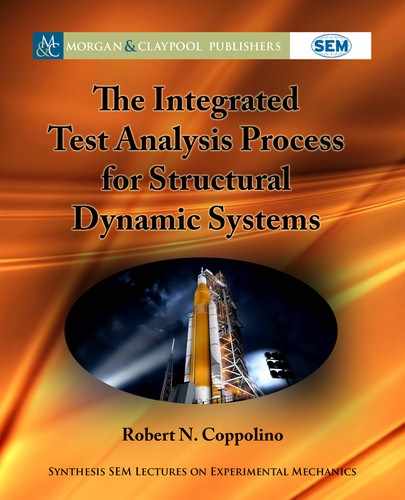18 2. DEFINITION OF TEST ARTICLE FINITE ELEMENT MODELS
2.2.6 RESPONSE SPECTRUM AND SHOCK SPECTRUM
Two closely related “signature” functions for linear SDOF system response to transient excitation
are the response spectrum and shock spectrum [15]. e response spectrum is associated with
response of a unit mass SDOF system excited by an applied force, F .t/, in particular,
Ru.t / C2
n
!
n
Pu.t / C!
2
n
u.t/ D F .t /: (2.46)
e maximum and minimum response map linear SDOF systems to a specific force
history, F .t/, with selected value of
n
for the range of natural frequency, 0 < !
n
< !
max
is defined as the response spectrum. e response spectrum is defined for extremes in dis-
placement, velocity and acceleration response. Normalized response spectra are defined (using
F
0
D max.jF .t/j/) as follows:
RD
.
!
n
;
n
; F .t/
/
D
max
!
2
n
u.t/=F
0
; min
!
2
n
u.t/=F
0
RV
.
!
n
;
n
; F .t/
/
D
Œ
max
.
!
n
Pu.t /=F
0
/
; min
.
!
n
Pu.t /=F
0
/
RA
.
!
n
;
n
; F .t/
/
D
Œ
max
.
Ru.t /=F
0
/
; min
.
Ru.t /=F
0
/
:
(2.47)
e shock spectrum is associated with response of a linear SDOF system excited by an
applied base acceleration, in particular,
Ru
R
.t/ C 2
n
!
n
Pu
R
.t/ C !
2
n
u
R
.t/ D Ru
0
.t/; (2.48)
u
R
.t/ D u.t/ u
0
.t/: (2.49)
e maximum and minimum response map SDOF systems to a specific base accelera-
tion history, Ru
0
.t/, with selected value of
n
for the range of natural frequency, 0 < !
n
< !
max
is defined as the shock spectrum. e shock spectrum is defined for extremes in relative dis-
placement, relative velocity and absolute acceleration response. Normalized response spectra are
defined (using
R
U
0
D max
.
j
Ru
0
.t/
j
/
) as follows:
SD
.
!
n
;
n
; Ru.t/
/
D
max
!
2
n
u
R
.t/=
R
U
0
; min
!
2
n
u
R
.t/=
R
U
0
SV
.
!
n
;
n
; Ru.t /
/
D
max
!
n
Pu
R
.t/=
R
U
0
; min
!
n
Pu
R
.t/=
R
U
0
SA
.
!
n
;
n
; Ru.t /
/
D
max
Ru.t /=
R
U
0
; min
Ru.t /=
R
U
0
:
(2.50)
2.2.7 ILLUSTRATIVE EXAMPLE: HALF-SINE PULSE FORCE
Consider the half-sine pulse force excitation, shown in Figure 2.2. e normalized displacement
response spectrum (assuming
n
D 0:02) for this excitation is also shown in Figure 2.2.
A more commonly employed plot of response spectrum is based on the peak absolute
values of the function, as depicted in Figure 2.3.
A useful property of the absolute displacement response spectrum is that its asymptotic
value, for frequencies above f
approaches unity. e physical significance of the cut-off fre-
quency, f
, is that linear SDOF systems with natural frequency, f
n
> f
, respond “quasi-
statically” to the excitation environment, F .t/, i.e., the excitation is “slowly varying” for a system
..................Content has been hidden....................
You can't read the all page of ebook, please click here login for view all page.
